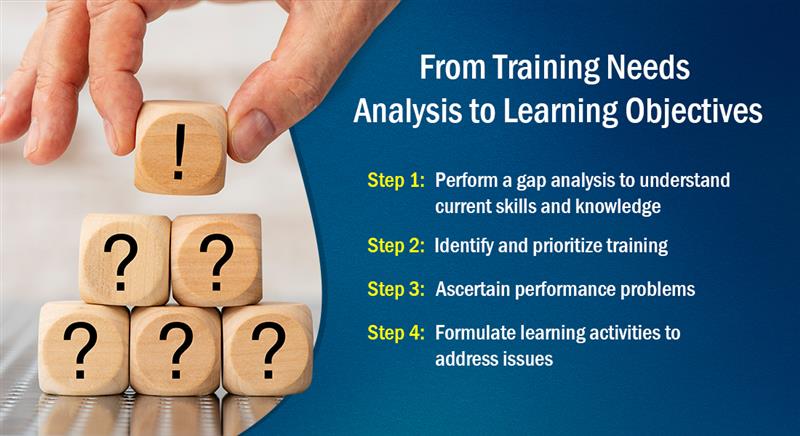Get Performance-based Learning Objectives Right with Training Needs Analysis
Learn what training needs analysis is and its objectives, and the steps involved in conducting training needs analysis to create performance-based learning objectives.

Do you conduct a training needs analysis in your organization before deciding on corporate training? Or do you skip it entirely and directly jump into planning your training initiatives? If so, just how effective is that kind of training?
What is Training Needs Analysis?
The process of identifying training and development needs of employees so that they can do their job effectively.
What are the Steps Involved in Setting the Right Performance-based LOs?
Step 1: Perform a gap analysis to understand learners’ current skills and knowledge
Step 2: Identify and prioritize training needs
Step 3: Ascertain learners’ performance problems
Step 4: Formulate learning activities & delivery strategies to address issues
Your online learning strategies may contain all key ingredients: good eLearning interactivities, appealing design, assessments for evaluating learners, and mechanisms to collect learner data/feedback. However, can you say confidently that your training addresses all the performance issues your learners may be facing at work on a day-to-day basis?
Every training must, at the risk of stating the obvious, strive to boost learner performance. To that end, clearly defined learning objectives that focus on addressing learners’ performance problems in the workplace are a must. Training needs analysis is one of the strategies successful companies use to set performance-based learning objectives.
In this blog, I will briefly take you through what training needs analysis is, what its objectives are, and the steps involved in conducting training needs analysis to create performance-based learning objectives.
Have you explored our all in all guide on rapid eLearning yet?
What is Training Needs Analysis and How to Implement It?
What is Training Needs Analysis and What are its Core Objectives?
According to an article in The Economic Times, training needs analysis (TNA, hereafter) is defined as “the process in which the company identifies training and development needs of its employees so that they can do their job effectively. It involves a complete analysis of training needs required at various levels of the organisation.”
A training needs analysis is conducted to answer what:
- Results does the company expect/require from its employees?
- What knowledge/skills/behaviors do learners currently exhibit at the workplace?
- What knowledge/skills/behaviors must they gain to close the performance gaps?
Usually employees need training to:
Therefore, you can carry out TNA to fill a growth gap or close a performance gap. |
To put it in simple terms, a successful TNA identifies who needs training and what kind of training is needed. By conducting a TNA, trainers will be able to:
- Come up with the right kind of learning activities to bridge performance gaps (more on this later in the blog)
- Communicate to learners how the training will help them improve their skill sets to achieve their fullest potential
What are the Steps Involved in TNA to Set the Right Performance-based LOs?
There are many approaches to performing a TNA and using that data to set performance-based learning objectives. However, we will look at one that has worked for most Fortune 500 companies around the world—one that will get to the root of the ‘performance problem’ in the most effective way.
Let’s jump right in.
1. Perform a Gap Analysis to Understand the Learner’s Current Skills and Knowledge
To identify how to improve your employees’ performance, it is important to first understand what they are currently doing wrong. And that can be understood by performing a gap analysis.
Performing a gap analysis involves looking at how the employee is currently performing at the workplace and compare it against the performance standards of your organization. Here’s a small table that better illustrates this point.
| Current Situation | Determine the current skills, knowledge levels, and work behaviors of employees.How do you gather this information?
You can also gather performance data from each employee’s performance appraisals, their met and unmet work quotas, the number of safety incidents they may have caused or been involved in, the number of customer complaints, and more. |
| Desired Situation | Identify the desired behavior and skills you wish employees to gain. This includes analyzing the essential job tasks or standards, and the skills and abilities employees need to have to perform well at their job.Here are some questions you must consider when conducting a task analysis:
While you are at it, try to answer these questions too:
Note: Here, there is no attempt to understand why they are unable to perform; that is done in step three. |
By identifying the “gap” between the current situation and desired situation, you can determine what the training needs to achieve.
2. Identify and Prioritize Training
Now that you have a list of training needs, you must evaluate them against the bigger picture, the organizational goals.
How realistic is the training solution? Are there any constraints to its implementation?
In other words, the second step of TNA expects trainers to consider the organizational goals and requirements to:
- Determine if the training needs are real and worth addressing
- Specify the level of importance and immediacy to each of these needs
Here are some questions to help you determine the importance of the training needs:
How much damage is the performance problem causing your organization and how cost-effective is the proposed training solution? How much will the training cost? In other words, perform a cost-benefit analysis to see if the training will result in a greater return than the initial investment to administer the training.
Do you have any training legally mandated for your employees? For example, most organizations need to conduct compliance and regulatory training half-yearly or yearly.
Does your top management want a quick solution to the current employee performance problems?
Do you have the resources to implement the required training solution—or do you need to outsource training design/development?
3. Ascertain Learners’ Performance Problems
We have looked at how you must consider the personal needs of the learner and evaluate them against the goals of the organization. The next step is to identify the specific problems they may be facing at the workplace.
There are two questions you need to ask:
|
4. Formulate Learning Activities & Delivery Strategies to Address Performance Issues
Simply identifying performance issues won’t be of any use unless you plan to do something about it. Trainers ought to study the information they have (the performance issues and what’s causing them) and devise appropriate strategies to help fill those performance ‘gaps’ once and for all.
For example, in most cases, the drop in employee performance is attributed to ineffectiveness of the training program. Specifically, it boils down to the:
- Nature of the training content (how well is the learner able to understand, retain, and recall the information to apply at work)
- Mechanisms used to deliver the training to learners
Looking at these two aspects and making necessary adjustments can improve performance. Here are a few recommendations on how to solve common training problems that cause performance issues (directly or indirectly):
Content
- Include real-life scenarios/case studies and allow learners to reflect critically on their decisions to impart decision-making skills (in sales training or customer service assistance training).
- Divide a lengthy training session into 10 to 15-minute microlearning modules to help improve knowledge retention.
- Use gamification techniques to foster competition among learners.
Delivery
- Consider investing in a learning management system (LMS) for seamless 24X7 access to learning on any device.
- Facilitate remote learning by providing short modules that can be accessed on mobile devices and tablets.
- Provide on-the-job support to learners by giving access to the required content – PDFs, infographics, videos, FAQs – hosted on the LMS/portal.
Parting Thoughts
So, there you go. These are the steps involved in carrying out a training needs analysis – an analysis that equips you with information on how well or badly learners are performing and insights into what must be done to fill these performance gaps and enables you to come up with performance-based learning objectives that communicate the importance of the training not only to you but also to your learners.





